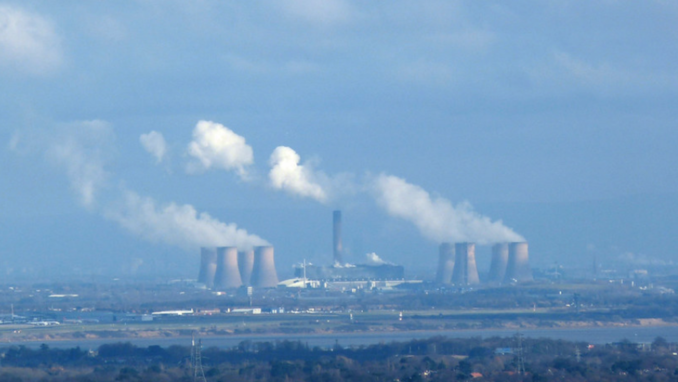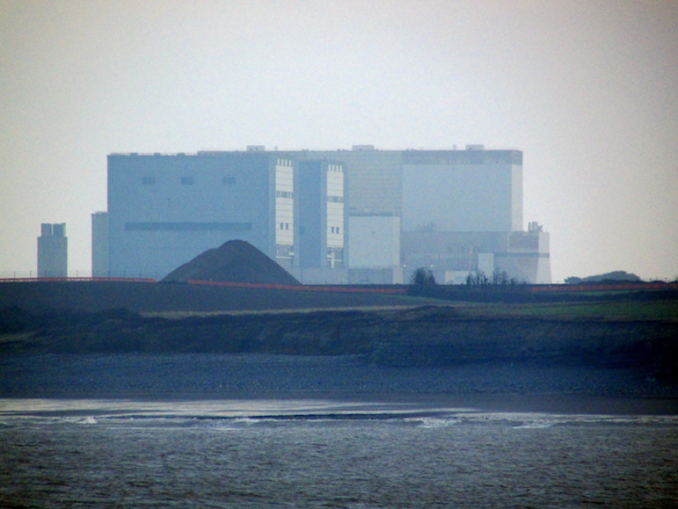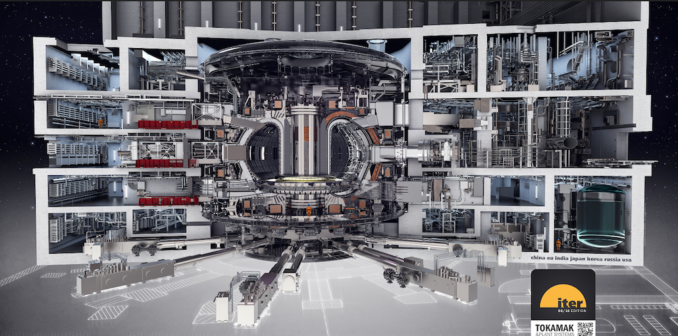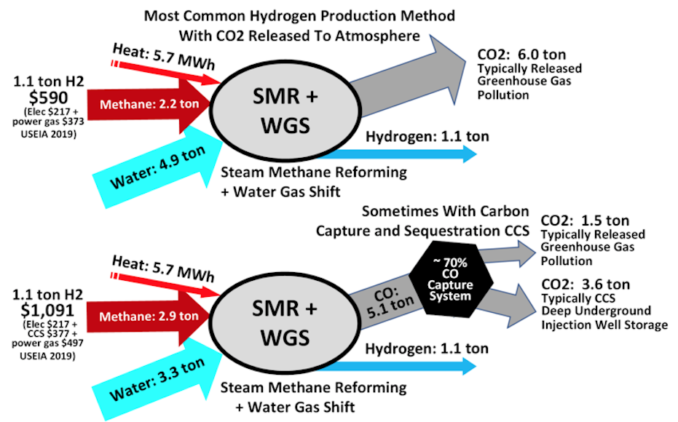Last time in UK Electricity Supply Bloodbath? we concluded that, across the next decade, Britain’s positive electricity margin becomes a deficit as an older generation of nuclear and coal-fired power stations come to the end of their lives without being replaced.
The interconnectors which import power from the continent have a limited capacity and will be affected by intermittent renewable generation from a de-carbonising Europe.
The UK’s dash for wind has been an expensive flop.

View From Halkyn Mountain – Fiddler’s Ferry Power Station,
Andrew – Licence CC BY-SA 2.0
What’s to be done? Let’s have a look at the alternatives, keeping in mind the following:
- A big coal-fired Central Electricity Generating Board era power station had a capacity of about 3,000MW
- According to Business Electricity Prices, the wholesale price of electricity is £70/MWh.
- Peak UK demand is about 45,000MW
Solar
The biggest solar farm in the world is at Bhadla in India but produces only 2,245MW of electricity despite covering 14,000 acres. During the night it produces none.
Hydro
The biggest hydroelectric scheme in the world is the Three Gorges dam in China. It has a capacity of 22,000MW but is 600 ft high, 7700 ft wide and has created a reservoir that measures 400 square miles. The dam raises the river and tributary levels upstream for 270 miles (ie London to Penrith) and takes water from a catchment area covering 370,000 square miles – 4 times the size of the UK.
The Grand Coulee dam in Washington State in the Pacific North West of the United States has a catchment area of 74,000 square miles – fifty percent bigger than England. The lake behind it is 151 miles long. Despite an installed capacity of 7,000MW, according to the US Department of the Interior Bureau of Reclamation, it averages 2,300MWh of generation – less than one of those CEGB coal-fired power stations and only 32% of its installed generating capacity.
Why is hydroelectricity so inefficient? Because of the intermittent nature of rainfall. The graph here shows rainfall in the Southern Water area across the last 12 months, with April being particularly dry.
Remember, when they tell you there’s been a month’s rainfall in a day, all they are doing is comparing an ordinary day’s rainfall from a wet month with an entire dry month.

Three Gorges Dam,
Hugh Llewelyn – Licence CC BY-SA 2.0
Wind
In the last episode, we looked at wind and discovered in reality it costs £90+ per MWh, not least because of the excessive rents paid to landowners.
When cabinet ministers say wind power is the cheapest form of electricity, they are lying.
Intermittent because of the weather, supply is less than one percent of demand for days on end, despite an installed capacity of 28,000MW. Ofgem’s statistics show wintertime wind-powered generating availability to be between 12% and 24% whereas nuclear and fossil fuel availability are 80%+.
Tidal Power
The proposed Swansea tidal lagoon would have covered over four square miles, encircled by a five-mile-long causeway, and would have cost well north of £1 billion. Even so, it would only have been worth installing 320MW of capacity. Most of the time generation would be much less, or nothing at, because of the intermittent movement of tidal water both during the day and at different times of the year and the constantly varying ‘head’ between the water level and the turbines.
There is such a thing as a marine tidal turbine. These are like wind turbines except underwater. Although the tide is more predictable than the wind, it will never turn the turbine as quickly as the wind might. Also, as water is much denser than air, the marine turbines have to be very solidly built. Two experimental turbines at Strangford Loch had a combined capacity of 1.2MW. Two big wind turbines might have a capacity of 20MW. Called SeaGen, the Strangford Lock unit weighed 300 tons and was said by its operator to work at a capacity factor of 0.59, generating only 0.7MWh of electricity.
***
In conclusion, there isn’t enough energy in sunshine, moving air or moving water to generate enough electricity for a small densely populated county like Britain.
The energy we need lies within the atom and in the bonds between hydrocarbon atoms. But.
***
Nuclear
Extracting energy safely from the atom is difficult and expensive. The strike price (the price at which electricity is sold into the marketplace) for the new Hinkley Point C power station under construction in Gloucestershire is guaranteed by law. The wholesale market will be forced to buy at a 2012 index-linked price of £92.50 per MWh.
Between the contract being signed in 2012 and the power station generating, at least 15 years will have passed. When index-linked up to 2021, the strike price is now £110.75 per MWh, 57% above the current wholesale price of £70.
The expensive part of nuclear power is the vast cost of building the power station. The biggest single expense is servicing the debt. Bearing in mind how Hinkley Point C is being financed, two-thirds of that cost goes to the Chinese Communist Party. Joris van Dorp’s pie chart calculates the interest on Hinkley Point C electricity at an eye-watering 77 Euros per MWh.

Hinkley Point Nuclear Power Stations,
Reading Tom – Licence CC BY-SA 2.0
Another nuclear power station is mooted for Bradwell in Essex. At the moment the project is partway through the five to seven-year process which precedes construction. If building work were to begin, it would take another 9 to 12 years to complete the power station.
Bradwell remains years away from the ‘final investment decision’, the point at which proposed power stations at Moorside (in Cumbria) and Wyfra (Anglesey) were abandoned by Mitsibusi and Hitachi respectively.
In brief, nuclear power stations are too expensive to construct and take too long to build. Only one, 3300MW Hinkley Point C, is being built at present.
Small Modular Nuclear Reactors
Rolls Royce promises a Small Modular Reactor or SMR. At the moment, Rolls Royce makes nuclear reactors for submarines. The SMR suggested is a 400MW unit, meaning eight equate to one Hinkley Point C.
In their guff, Rolls Royce uses the ominous word ‘innovation’, suggesting a huge amount of time and expense is required for research and development with the accompanying risk that SMR might not work or will be bigger, more expensive and produce less power than the prospectus suggests.
According to Wiki, existing working SMRs appear to be adapted ice breaker and submarine reactors. RR’s 400MW output looks optimistic. Russia’s KLT-40S is rated at 35MW (1/100th of a Hinkley Point), their RITM-40 at 40MW. Most other SMR projects are labelled as ‘conceptual designs’.
RR’s SMR is nothing like a submarine reactor. They are starting from scratch. It will cost a fortune and there is no guarantee it will perform as anticipated. Even if doable, as with Bradwell, it will be a decade or two before an SMR is able to provide to the National Grid.
Nuclear Fusion
There is a nuclear fusion plant called ITER at Saint-Paul-lès-Durance in the South of France. Unhelpfully blurred out on satellite mapping, it is not a power station but an experimental facility.
It is vast, with the total cost of the project put at E22 billion, with some estimates as high as $65 billion.

A drawing of the ITER tokamak and integrated plant systems shows the complexity of the ITER facility now under construction in France.,
Oak Ridge National Laboratory – Licence CC BY-SA 2.0
Heavy hydrogen is heated to a plasma while contained within a magnetic field until nuclear fusion produces more energy from the plasma than it takes to heat it up and contain it. At ITER about 200MW of excess energy can be created, but only in short bursts. The process involved is beyond complicated. Even if they get it to work it will be decades before the process can be used for a commercial power station.
The Problem With Hydrogen
Much has been said about using hydrogen instead of natural gas for heating and as fuel in cars. Hydrogen exists in hydrocarbons therefore producing it creates carbon as a byproduct. Hydrogen is made from methane (CH4, which is the major component of natural gas) and water in a process called steam reforming.

Graphic of Steam Methane Reforming to produce one ton of hydrogen,
Parent 55 – Public domain CC BY-SA 2.0
As can be seen, this method produces one ton of hydrogen but 6 tons of carbon dioxide. It also uses 5.7MWh of precious electricity.
In the second illustration, using less water and more methane produces less CO2 but the extra methane makes the hydrogen even more expensive.

Graphic of industrial process showing inputs into Methane Pyrolysis to produce one ton of hydrogen and other outputs.,
parent55 – Public domain
Another source of hydrogen is water (H20) via electrolysis. The above schematic suggests it takes 39.4MWh of electricity to produce 1.1 tons of hydrogen which when burned only produces 33MW of usable energy. You’d be better off just using the electricity. The carbon produced is solid and goes to landfill which environmentalists keep telling us is bad.
On the graphic, prices are in Dollars and based on US gas and electricity prices which are lower than in the UK. Therefore, we shall ignore that calculation and reference Carbon Commentary who claim the cost price per kilowatt-hour of hydrogen is just over 7.5 Euro cents (6.34p). The retail price will be much higher, meaning hydrogen looks to be much more than twice as expensive as natural gas. Your author’s gas tariff is 3.83p/KWh excluding, as Carbon Commentary’s figures will, VAT and the standing charge.
Carbon dioxide is handy stuff and has a thousand and one uses but is already produced via existing chemical processes including capture. Capturing and storing CO2 just for the sake of it is difficult, expensive and uses lots of precious energy. Not all of the CO2 is captured anyway, and what is has to be scrubbed via chemical processes to remove all of the other contents of natural gas and the byproducts of combustion.
Beyond carbonphobia, what is the point? It is estimated in 2019 US greenhouse gas emissions were 6.5 billion metric tons. What else can you do with it other than release it into the atmosphere in the form of a gas to be recycled into oxygen by plants?
Incidentally, if Puffins think 6.5 billion tons sounds a lot, the atmosphere weighs 5.5 million billion (ie 5.5 quadrillion) tons.
The plants might not even notice let alone thank us.
Follow the Science
Only 0.8% of the world’s population lives in the UK. Just 3.3% of the world’s economic activity takes place here, most of it in services rather than in high-carbon producing manufacturing and heavy industries. We consume 0.5% of the world’s coal and 1.2% of the world’s electricity. Only 0.04% of the earth’s atmosphere is CO2. According to government statistics, the 2010s were colder than the 2000s.
What happens here makes no difference to the global climate. The UK commitment to carbon zero is a farce.
Use Less
By all means, insulate your homes and save money. But insulation-max is a nonsense, requiring another layer of masonry to be built around the outside of your house. The place has to be hermetically sealed and new equipment installed to dehumidify the resulting ventilation free space. All doors and windows have to be replaced. Your house will have to be dug up to install the heat pump, wider pipes and bigger radiators. The heat pump will not heat the dwelling and residents will be buying electricity at 20p/KWh (instead of gas a 3.83p/KWh) to make up the difference. In Italy, insulation-max is budgeted at E100,000+ per family home. This is unaffordable except for a small number of government-funded virtue signalling dwellings.
Having said that, it doesn’t matter how many efficiencies are made domestically, a rising population, compulsory electric cars and replacing gas central heating with electric-powered heat pumps will suck the National Grid dry.
Natural Gas
En cue, and for the first time in two years, a man came to read the gas meter.
“It’s getting expensive,” I ventured. “Is it because of supply and demand or speculation in the spot and futures markets?”
“China’s buying it all up,” he replied.
Bloomberg called. The meter man had a point. “China begins winter buying spree at the worst possible time,” was their headline. The article continued,
China is escalating its purchases of liquefied natural gas for the winter, exacerbating a global supply shortage and leaving less fuel for energy-parched Europe. China is struggling to secure enough coal to power factories and heat homes this winter, as the world’s second-biggest economy faces a potential energy-crunch scenario similar to the chaos gripping Europe. That’s spurred some of the nation’s energy giants, such as state-owned Sinopec, to dive back into the LNG spot market, seeking shipments of the heating fuel in preparation for when temperatures turn colder.
The reason? According to Bloomberg, two-fold, Chinese coal production has been badly affected by recent flooding and because they can.
Although until now Russian gas headed east to west, in future with the opening of the Yamal terminal in Siberia, liquified Russian natural gas can head east to China.
Interuption of Supply
As things stand, the most likely response to the UK’s approaching electricity deficit is a further dash for unreliable and expensive wind, aided by interruption of supply. Large non-essential consumers, such as car factories, will be paid to stop production – with your money. Secondly, supply will be cut off via the smart meter system and prohibitive price charging therein. Thirdly, rolling windless weather forecast postcode power cuts will make flicking a switch as complicated as visiting a care home, seeing a doctor or finding a dentist.
On the other hand.
Author’s Recommendations
It might sound odd to recommend a dash for gas when the price is spiking but there seems no alternative. The Chinese via Yamal, the Germans via the Nord Steam Two pipeline and the Japanese by any which way they can, have already started.

Nord Stream – two pipes are welded together on the Castoro Sei pipelaying vessel,
blair 175 – Licence CC BY-SA 3.0
Ignoring the arbitrary ‘carbon cost’, gas-fired electricity is still cheaper than wind or nuclear. The government’s own predictions (Chart 4.1) for projects commissioning in 2025 show gas-fired power production at £53/MWh, way below wind at £90+/MWh and Hinkley Point C at £110+/MWh.
Remember, if anyone tells you wind is the cheapest form of electricity generation, they are lying. We know better having, in the last episode, looked at the government’s own figures and the accounts of the wind farm companies.
The advantage to the UK is that we have our own supplies of natural gas in the North Sea and abundant fracking gas on mainland Britain. Get drilling.
Much of the infrastructure is in place. As the dash for gas in the nineties showed, plants are quick to build and can be of variable sizes. 22,000MW of capacity was installed in the 1990s as coal production ended.
The worst of demand-side disrupting spikes and supply-side destroying price crashes can be smoothed out by hedging the spot and future markets with long term supply agreements from Russia, the USA and the Gulf. A new Liquid Natural Gas terminal or two is needed.
The coal-fired power stations should be kept open, extended and new ones built. As we saw with the proposed new coking coal mine in Whitehaven, communities will welcome the jobs. England’s struggling coastal towns would benefit.
Petrol and diesel vehicles and gas central heating should not be banned.
Banks and shareholders, not the taxpayer, should shoulder the risk of Rolls Royce’s SMR.
On windy days, surplus electricity can be sold to the continent. Wind farm owners can bid against gas, coal and Hinkley Point to provide to the gird – or go bankrupt.
Carbonphobia should be classified as a mental illness. Net-zero and 1.5C should be called out as stress-related compulsive personality disorders.
The obsession with global warming and climate change should be replaced with concern over pollution and the environment, balanced against maintaining living standards.
As our new generation of hydrocarbon power stations reach the end of their lives in 2050, there may be a safe, easy and cheap nuclear alternative. Then again, there might not. Keep drilling.
If the above requires the removal of Johnson and his trivial wife, so much the better.
Puffins are welcome to make their own suggestions below the line while keeping in mind these three important considerations:
- Cost
- Timescale
- The laws of physics
© Always Worth Saying 2021
The Goodnight Vienna Audio file



